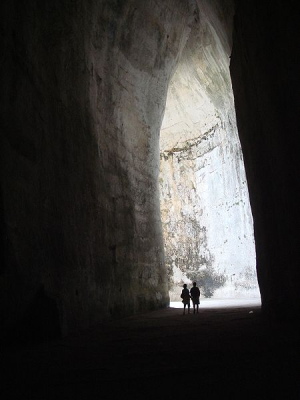
L’Orecchio di Dionisio (“The Ear of Dionysius”) in Syracuse.
When the painter Michelangelo
da Caravaggio, fleeing from Malta, sought
refuge in Syracuse where he was hosted by fellow painter Mario
Minniti, he visited the area of the latomìe
(quarries) in 1608, and it was here that according to tradition he himself
named this ancient quarry of the Greek era the "Ear of Dionysius" (for
the shape of the entrance, which vaguely resembles that of a human ear).
(Note: the definition of "Ear of Dionysus" that one sometimes encounters
is incorrect. The name alludes, in fact, to the Syracusan “tyrant” (king)
Dionysius
I, and not to the Greek god, Dionysus).
 |
| The entrance to the Ear of Dionysius as seen from outside. |
The cave, a virtual “Gothic cathedral”
of dizzying height (23 meters / 75.5 feet),
tunnels sinuously into the rock for 65 meters / 213
feet, following the path of an ancient aqueduct.
The diggers began the excavation, in fact,
from the aqueduct, avoiding the rock layers above (which were of a lower
quality because of water infiltration) and proceeded to gradually dismantle
the floor to an increasingly wide area, until reaching the actual level
of the ground.
This technique had the effect of shaping
the cave in the curious form of a “pavilion,” which one can also find in
other parts of these quarries as well as in the Quarries
of the Capuchins.
One can still easily distinguish on the walls the parallel lines of successive layers of rock that were "peeled away" one after another. For this operation, the workers made use of wooden wedges, which, when wet and expanded, split the stone in a relatively straight line.
In the cavity resulting from this immense excavation work a curious phenomenon of echoes was created (obviously in a way that was completely unintended), which gave rise to the fanciful legend that the caves were built by Dionysius in order to spy on his prisoners, who spoke with complete freedom not knowing that their whispers were audible, thanks to the play of echoes, on the opposite side of the cave.
Until a few years ago, generations of guides amazed tourists who, from a distance of many meters, could easily hear the sound of a piece of paper being torn, “miraculously” amplified by the echo. Today, in the absence of such guides, visitors themselves have fun attempting to make a sound echo the greatest distance.
How to Reach the Ear of Dionysius from
the Algilà Ortigia Charme Hotel.
The Ear of Dionysius is part of the Archaeological
Park of Syracuse, which is located off the island of Ortigia
and more precisely at the extreme north of the ancient city (Neapolis).
A route by foot is possible, but it will exceed one kilometer
/ 0.62 miles in distance.
Those who do not have their own transportation
can call a taxi from the reception desk at a special rate or use the bicycles
that the Hotel Algilà offers to its guests for free.
Alternatively, one can take the (free)
shuttle bus #20 from the nearby Piazza
Archimede up to the bus station (near the train station) and
then take either one of the following bus lines: 6, 8, 11, 12 or
13.
Otherwise, from Riva Nazario Sauro (behind
the nearby Piazza delle Poste) one can choose from the following bus lines
1, 2, 3, 4 or 12.
 |
| The entrance to the Ear of Dionysius as seen from inside. |
The park is open every day, including holidays, from 9:00 a.m. until two hours before sunset.
The area is organized in such a way as to be accessible from a convenient road, which is easy to follow even for those who have difficulty walking. Admission is free for people with disabilities and for those who accompany them.
Back to TOURISM IN SYRACUSE, SICILY